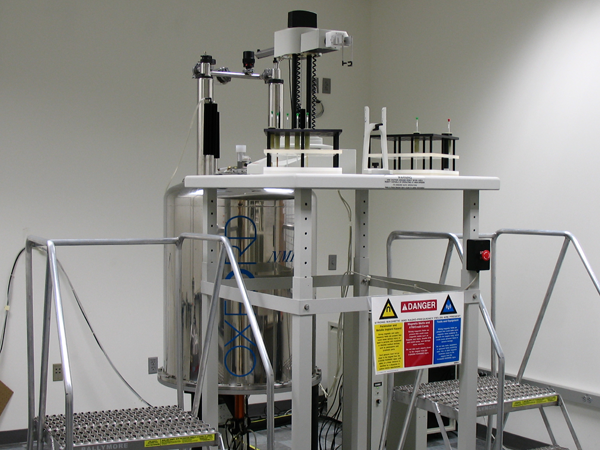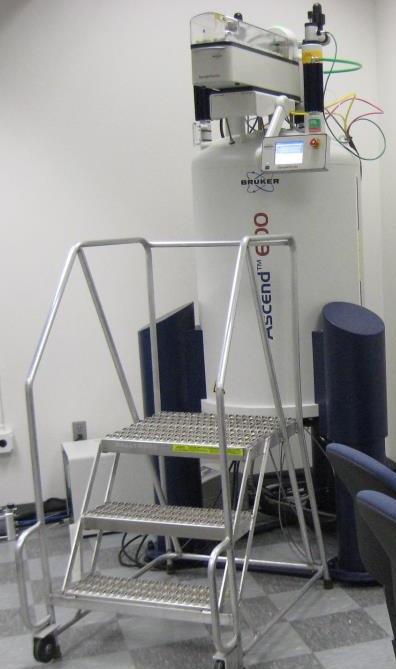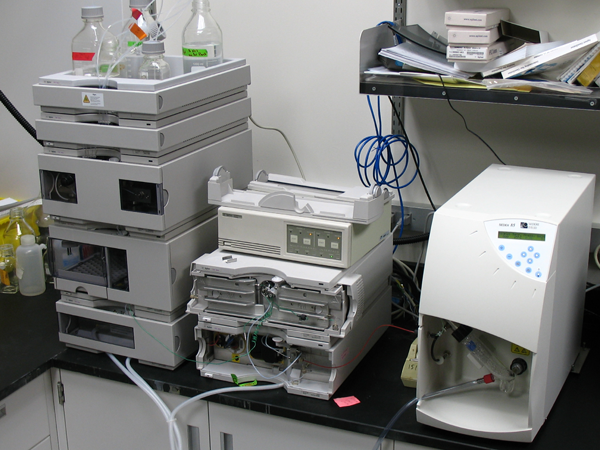Instrumentation
The Chemistry Department at UAF has a wide range of modern instruments available for research, and undergraduate and graduate instruction.
Molecular Imaging Facility
The Molecular Imaging Facility provides access to state-of-the-art Magnetic Resonance
techniques for the UA system. The facility has two NMR spectrometers: 300 MHz for
solution studies, and 600 MHz for solutions or solids. The facility also has a 1.5
Tesla Magnetic Resonance Imaging (MRI) scanner that can be used for both imaging and
spectroscopy, and a dual-energy X-Ray absorptiometry instrument for tissue studies.
MIF website
Varian Mercury 300-MHz NMR Spectrometer
 The department has a 300 MHz Varian NMR for use in undergraduate labs (mainly organic
chemistry) and research. It has a broadband probe tunable to most nuclei including
hydrogen, carbon, fluorine, phosphorus, nitrogen, and vanadium. It is capable of one
and two dimensional NMR experiments. It was obtained through a grant from the National
Science Foundation Instrumentation and Lab Improvement (NSF-ILI) program.
The department has a 300 MHz Varian NMR for use in undergraduate labs (mainly organic
chemistry) and research. It has a broadband probe tunable to most nuclei including
hydrogen, carbon, fluorine, phosphorus, nitrogen, and vanadium. It is capable of one
and two dimensional NMR experiments. It was obtained through a grant from the National
Science Foundation Instrumentation and Lab Improvement (NSF-ILI) program.
Bruker AV-600 NMR Spectrometer
 The Department has a 600MHz Bruker NMR for use in research including undergraduate
research. This system includes both a broadband liquids probe that can tune to most
nuclei and an HR-Magic Angle Spinning probe designed for proton and carbon NMR on
tissues and other semi-solids. It has a 60 position sample changer that allows for
complete automation of experiments.
The Department has a 600MHz Bruker NMR for use in research including undergraduate
research. This system includes both a broadband liquids probe that can tune to most
nuclei and an HR-Magic Angle Spinning probe designed for proton and carbon NMR on
tissues and other semi-solids. It has a 60 position sample changer that allows for
complete automation of experiments.
Gas Chromatograph with Mass Selective Detector
 The department has an Agilent 5975C GC-MS , which is used for separating and identifying the components of volatile complex mixtures.
The capillary column allows for separation of complex mixtures into individual components
that are analyzed by mass spectrometry as they exit the column. Database searching
software is used to identify the components. It is used mainly for environmental chemistry
research projects, however students in instrumental analytical chemistry lab (Chem
413) also use the instrument as part of their regularly scheduled lab.
The department has an Agilent 5975C GC-MS , which is used for separating and identifying the components of volatile complex mixtures.
The capillary column allows for separation of complex mixtures into individual components
that are analyzed by mass spectrometry as they exit the column. Database searching
software is used to identify the components. It is used mainly for environmental chemistry
research projects, however students in instrumental analytical chemistry lab (Chem
413) also use the instrument as part of their regularly scheduled lab.
The 5975C is equipped with a CTC Combi Pal sample processing robot. The robot can inject various kinds of samples under computer control, including microliter volumes of liquids, vapor from the headspace of a closed sample bottle, or chemicals adsorbed on a solid phase microextraction (SPME) fiber.
We also have a Hewlett Packard 6890 gas chromatograph with flame ionization and electron capture detectors, and an autosampler. This is used for organic chemistry lab (Chem 324) and instrumental analytical chemistry lab (Chem 413).
High Performance Liquid Chromatograph (HPLC)
 The Agilent gradient HPLC with UV/VIS diode array and mass-sensitive detectors is
used for separating and identifying the components of nonvolatile complex mixtures.
It complements the GC-MS, and is particularly useful in separating compounds of biological
interest.
The Agilent gradient HPLC with UV/VIS diode array and mass-sensitive detectors is
used for separating and identifying the components of nonvolatile complex mixtures.
It complements the GC-MS, and is particularly useful in separating compounds of biological
interest.
Capillary Electrophoresis
 This instrument was also obtained with NSF funding as part of a Separation Science
package including new experiments for undergraduate laboratory classes. The CE separates
charged molecules that migrate down a narrow liquid-filled capillary under the influence
of a 10,000-volt electric field. Molecules with a non-zero charge, such as amino acids,
proteins, and nucleic acids, are often separated by CE.
This instrument was also obtained with NSF funding as part of a Separation Science
package including new experiments for undergraduate laboratory classes. The CE separates
charged molecules that migrate down a narrow liquid-filled capillary under the influence
of a 10,000-volt electric field. Molecules with a non-zero charge, such as amino acids,
proteins, and nucleic acids, are often separated by CE.
UV-Visible Diode Array Spectrometers
 We have three Hewlett Packard 8452A and one Hewlett Packard 8453A diode array UV/VIS
spectrophotometers for quantitative analysis of UV-absorbing and colored solutes.
We have three Hewlett Packard 8452A and one Hewlett Packard 8453A diode array UV/VIS
spectrophotometers for quantitative analysis of UV-absorbing and colored solutes.
Fourier Transform Infrared (FT-IR) Spectrometer
A research-quality Thermo Scientific Nicolet iS50 FT-IR spectrometer is used for structural characterization of organic compounds and for quantitative analysis of certain gaseous and liquid phase solutes in organic, analytical, and physical chemistry labs. We have a 10-m gas sampling cell and sampling hardware for diffuse reflectance, attenuated total reflectance, and external reflectance geometries.
Computational Chemistry
Gaussian, ORCA, and MOPAC computational programs are installed on department servers, with Internet access via WebMO. This system is used by researchers and students in undergraduate labs . Visit the Chemistry Computational login page
Research Computing Systems (RCS) at the UAF Geophysical Institute provides advanced computing, storage, data sharing solutions and research IT support to University of Alaska research communities, collaborators and supporters. The Gaussian computational program is installed on the Chinook HPC cluster, and may be accessed from any on-campus computer using the SSH protocol, as in the PuTTY program in Windows or the ssh command on Linux terminal.
Other Instrumentation
The Department has Sorvall RC5B centrifuges and a Beckman Optima LE-80K ultracentrifuge. A variety of balances, ultra-low freezers, about 40 large fume hood-protected benches, and a large chemical storage facility are also available. Biochemistry research labs contain cell culture facilities, sterilizers, a confocal fluorescence microscope, and other specialized equipment.
Affiliated Instrumentation Centers
The Advanced Instrumentation Laboratory (AIL), has many additional analytical tools, which include:
Agilent 7500ce Inductively Coupled Plasma Mass Spectrometer
Panalytical X’Pert MRD Material Research Diffractometer
Panalytical Axios X-ray Fluorescence Spectrometer
Fourier Transform InfraRed Microscope (FTIR-microscope)
Pacific Nanotechnology Nano-R Atomic Force Microscope
JEOL 1200 Transmission Electron Microscope
ISI-SR-50 Scanning Electron Microscope
Postnova AF2000 Asymmetrical Field Flow Fractionation System
Thermo Scientific Nicolet 6700 Fourier Transform Infrared Spectrometer
JEOL JXA-8530F Electron Microprobe
The Water and Energy Research Center (WERC) at UAF also includes many instruments for water and isotopic analysis. See the website for details.


